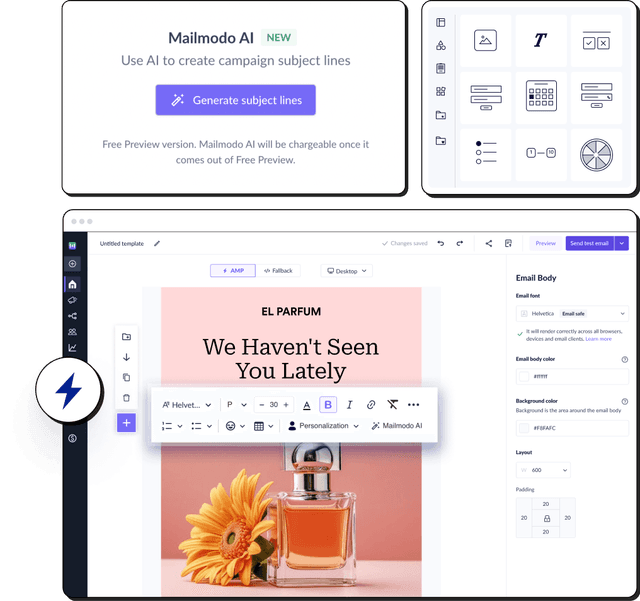What are spam traps?
Spam traps, also called honeypots, are email addresses that mailbox providers (ISPs, email clients, blacklist operators) use to identify people who send spam emails.
These email addresses can be old email addresses of actual people or email addresses created just to be used as a spam trap. So all of your old personal and work email IDs that you haven't used in years could now be potential spam traps.
How do spam traps work?
When an email is sent to a spam trap, the following process takes place:
1. Spam Trap Activation: When a spam trap receives an email, it activates a flag within spam detection systems. This event is logged and analyzed.
2. Analysis and Reporting: Anti-spam systems and email providers analyze the frequency and context of spam trap hits. Consistent hits from the same sender suggest problematic behavior.
3. Action Taken: Based on the analysis, email providers may block or filter the sender's emails, label them as spam, or take other corrective actions to prevent spam from reaching users' inboxes.
What are the different types of spam traps?
The different types of spam traps are as follows:
1. Pristine spam traps
Pristine spam traps are email addresses created by mailbox providers and other organizations solely to use as spam traps and have never been used by anyone before. Seeded spam traps and Honeypot spam traps are variations of pristine spam traps.
These traps are put out on public websites, but they are not directly visible. Instead, they are hidden and embedded within the site's background code. Mailbox and blacklist providers use this type of spam trap to find out who is scraping sites for emails or purchasing contact lists to create their email lists.
So these email addresses have never been used to sign up for an opt-in email list, log in to any website, or give out through a business card. Thus, it indicates that the only way a list will contain such email addresses is if the person has used questionable means to build the email list.
2. Recycled spam traps
Recycled spam traps are the email IDs that people once used and abandoned, which are now repurposed by email providers.
The time limit for an unused email address to be repurposed as a recycled spam trap typically ranges from 6 to 24 months. This period varies depending on the policies of the email provider or anti-spam organization.
These people may have signed up for your email list through their old work or personal email IDs that they have now stopped using. So the only way you would hit this trap is poor list management or not updating your email list for over 6 months.
Hitting a recycled spam trap is usually not as detrimental as hitting a pristine spam trap. But, over time, if left as is, it can damage your sender reputation.
3. Typo spam traps
Typo spam traps are misspelled email addresses intentionally or unintentionally provided by people when they sign up.
Sometimes a person can accidentally misspell their email addresses while filling out the signup form, and unfortunately for you, this misspelled email ID could be a spam trap.
Most commonly seen typos like "gnail" for "gmail" or "yaho" when writing "yahoo" could potentially be a spam trap.
Hitting these typo spam traps is also not as severe as hitting a pristine spam trap. But, it shows that you are not regularly cleaning your mailing list which can harm your sender reputation.
What happens if you hit spam traps?
Hitting spam traps can have several negative consequences for your email marketing efforts. Given below are a few consequences.
1. Decreased deliverability: Emails sent to spam traps can lead to lower deliverability rates, as email providers may start to classify your emails as spam.
2. Damage to reputation: Once your email deliverability becomes low enough, your emails start to land in the spam folders of your genuine recipients as well. This reflects poorly on your email practices, potentially eroding trust with recipients and harming your brand's credibility.
3. Blacklisting: Repeatedly hitting spam traps can result in your IP address or domain being blacklisted by major email providers and anti-spam organizations.
4. Legal and compliance issues: Persistent issues with spam traps can lead to compliance problems with regulations such as the CAN-SPAM Act or GDPR, potentially resulting in fines or legal action.
💡 Related guide: Email Rules and Regulations You Should Know in 2024
How to know if I have spam traps on my list
To identify spam traps on your email list, look for specific indicators that an address may be problematic. These include domain typos, addresses acquired through dubious methods like scraping or bulk purchasing, and outdated or invalid email addresses.
A significant drop in your email deliverability rates can signal the presence of spam traps. These addresses do not usually engage with emails and typically mark them as spam thus hampering inbox placement of your emails.
Utilize tools designed to analyze and clean your list for spam traps like ZeroBounce, NeverBounce, Validity, etc. If you suspect your list contains spam traps, check against well-known blocklists such as Spamhaus, Barracuda Central etc.
How to avoid spam traps

Spam traps can end up on your list in various ways, but they all stem from the same fundamental issue: inadequate email list management and maintenance. You can follow the best practices mentioned below to lower your chances of hitting a spam trap:
1. Avoid purchased lists
An email list bought off the internet has contacts who didn't opt-in to receive your emails, which means there is a high chance of your list containing different spam traps. Also, subscribers on such purchased lists can get annoyed by emails you send because they haven't signed up and mark your email as spam.
2. Use an email validation service to check your email list
To prevent typo spam traps from entering your email lists, you can add an email verification or validation tool to your signup forms to check if it's an actual email ID of a person. You can try out Bouncer, TheChecker, Hunter, etc. You can also verify email addresses after it has been collected by using APIs to check your mailing list or manually checking your list for misspelled or fake email IDs.
3. Use double opt-in in the signup process
Double opt-in is when people who sign up are sent a confirmation email to verify their email address, and only after verification are they added to your email list. So it will ensure that the email address in your list belongs to a person who checks their inbox.
4. Clean up your email lists at least bi-annually
You can use methods like sunset policy, and suppression list to clean your email lists. If people have not engaged with your emails in a while, you can also send them a final re-engagement email. And if they still don't respond, you can remove them from your list.
Using these, you can maintain a list with only active users and remove inactive and unsubscribed users periodically, leading to a healthy and clean email list.
💡 Related guide: How To Get A Clean Email List: Best Practices & Tools
Conclusion
Spam traps are critical indicators used to detect and penalize poor email practices, and encountering them can significantly harm your email deliverability and sender reputation. They can lead to decreased inbox placement, blacklisting, and compliance issues.
To mitigate these risks, follow the methods discussed in this article and maintain your email deliverability and reputation. Following the above-mentioned best practices will ensure that you do not hit any spam traps and that your emails reach your intended audience effectively.










